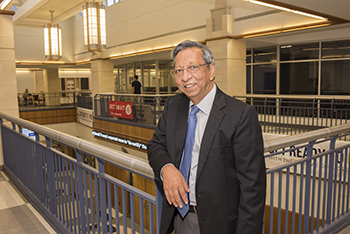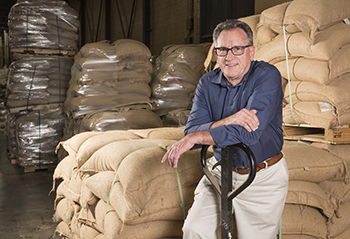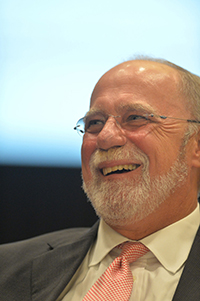Sailing for the horizon
Despite pandemic disruptions, the Port of Virginia looks to the future
Sailing for the horizon
Despite pandemic disruptions, the Port of Virginia looks to the future
Tariff wars and the COVID-19 pandemic delivered a one-two punch to the Port of Virginia, but officials are focusing on the positive as expansions are completed at the port’s two largest terminals, and a dredging project to make Virginia the East Coast’s deepest port is running ahead of schedule.
The third-largest East Coast port behind New York/New Jersey and Savannah, Georgia, Virginia achieved record-setting cargo volumes for six consecutive years before seeing its numbers fall off in fiscal year 2020. The port handled 2.75 million 20-foot equivalent units (TEUs) in fiscal 2020, about 181,000 fewer than the previous year. The decrease was largely due to tariff battles with China during the first half of the year, followed by the COVID-19 pandemic, which led to trade slowdowns across the shipping industry.
“The pandemic knocked us flat down,” says John Reinhart, CEO and executive director of the Virginia Port Authority. “We’re seeing a little bit of flattening where some services have been reinstated, but with the resurgence of COVID-19 in the U.S. and schools possibly not reopening, there’s the question of what happens to the demand for goods. There are very unsettled waters in front of us.”
In the wake of the pandemic, trade patterns may be altered, and some overseas manufacturing processes may return to the U.S., but Reinhart says the port is ready to respond to those contingencies. “Our business model is robust. Volumes will stabilize at some point and in the next year we should see a little bit of demand back up.”
COVID-19 seemingly impacted the port before other businesses in the state, with February seeing a 9% decrease in cargo as compared with the previous year. Nonetheless, the port adapted quickly to the pandemic. It continued to operate at full capacity while reducing weekday gate hours and eliminating weekend gate hours in response to lower cargo volumes. There were no employee furloughs, but salaries were frozen and bonuses suspended.

The port also implemented temperature scans for employees and social distancing, introduced new sanitization procedures and encouraged teleworking where possible. Isolated berths are available for emergencies, with the port staying in contact with vessels to identify problems and determine whether crew members have COVID-19-related symptoms. The port also established a critical cargo initiative, giving precedence to shipments containing COVID-19 test kits, medical equipment, hand sanitizer and other virus-related items. “We responded in a very mature and organized approach,” Reinhart says. “Everybody was committed to keeping the port open, the workforce safe and reducing the amount of exposure.”
Ready for recovery
COVID-19 impacted all East Coast ports, disrupting the supply chain and leading to volume declines through May, with Virginia recording the largest decrease at 9.2%. Data through May shows that the Port of Charleston saw the smallest drop at 5.2%, followed by Savannah at 6% and New York/New Jersey at 7.2%.
“Both New York/New Jersey and Virginia lost in market shares because of declines in total cargo,” says Vinod Agarwal, an economics professor and director of Old Dominion University’s Economic Forecasting Project. He notes that COVID-19 led to significant adverse effects on cargo handled at the port during April, May and June. “Our imports at the port were affected more severely than our exports,” Agarwal says. “Export loads had increased every month from January through March, whereas import loads had been falling since January.”
But even while dealing with lower volumes, blank sailings — scheduled vessel visits canceled due to low volume — and the pandemic, the port remains one of the commonwealth’s major economic engines. “Our port is available 24/7 for mega ships to come in easily,” Agarwal says. “The port has added more efficiencies over the past five or six years, so we should be able to export a whole lot more.”

Many of those efficiencies are the result of a nearly $800 million expansion project at Virginia International Gateway (VIG) and Norfolk International Terminals (NIT). Upgrades include modernized cargo handling, increased operational efficiencies and positioned Virginia to compete as the East Coast’s main container shipping port, with the capacity to process an additional 1 million containers annually.
The $312 million investment to increase VIG’s annual capacity to 1.2 million containers was completed in summer 2019. Upgrades include an 800-foot wharf extension, four new truck gate lanes, four 170-foot-tall ship-to-shore cranes (the largest in the Western Hemisphere), 26 additional rail-mounted gantry cranes, four new inbound truck gate lanes, three new container stacks and nearly 20,000 feet of new rail track.
At NIT, the port’s largest terminal, the $450 million investment includes 60 new rail-mounted gantry cranes, 35 new shuttle trucks, 30 semi-automated container stacks and two new Suez-class ship-to-shore cranes, 26 new inbound truck gate lanes and 60 additional truck queuing lanes. The project is slated to be completed by December when the ship-to-shore cranes — scheduled to be delivered in October — go into operation.
As a result of the modernizations, the terminals are operating more efficiently and safely while improving times for motor carriers. “These are positioning the port to be more competitive with additional capabilities and additional operations to attract more cargo as economies come back to life.” says David White, executive vice president of the Virginia Maritime Association.
Powering growth
The port also is contributing to Virginia’s efforts to develop a clean energy economy. In July, Gov. Ralph Northam announced that the state will use $14 million from the Volkswagen Environmental Mitigation Trust settlement to replace all-diesel cargo handling equipment at the port with zero-emission all-electric equipment. Two all-electric ship-to-shore cranes will be installed at NIT, while the Richmond Marine Terminal will receive all-electric yard tractors and charging infrastructure. The project is expected to eliminate more than 3,000 tons of diesel pollution and more than 71,000 tons of greenhouse gases, as well as the use of more than 6 million gallons of diesel fuel.
The port has already been working to reduce emissions and promote clean energy. “We have been building an electric approach at our facilities and reducing the carbon footprint across the port substantially,” says Reinhart. The port has installed LED lighting, deployed hybrid shuttles and instituted a reservation system that gets trucks in and out in 30 minutes instead of 90 minutes.
Meanwhile, the port is repurposing Portsmouth Marine Terminal (PMT) into a long-term multiuse facility. Reduced import volumes accelerated PMT’s planned shuttering, as the port eliminated ship calls to PMT in May and used the terminal to provide berthing during the summer for three cruise ships idled by the pandemic.
Earlier this year, Denmark-based renewable energy company Ørsted AS leased 1.7 acres at PMT to stage materials and equipment for Dominion Energy Inc.’s wind energy project off the coast of Virginia Beach, as well as other East Coast offshore wind energy developments.
This summer, Dominion finished construction on its first two offshore wind turbines 27 miles off the coast of Virginia Beach. The $300 million pilot project is the first offshore wind farm installed in federal waters and is the first phase in Dominion’s $7.8 billion plan to build the largest wind farm in North America, with 200 turbines to be built by 2026.
The nascent offshore wind energy project is expected to create about 14,000 jobs in Virginia.
“We believe that offshore wind is an opportunity for the Hampton Roads region and the Port of Virginia to become an anchor in the supply chain for the East Coast,” Reinhart says. “What we are doing here is creating an infrastructure that supports not only Virginia but others up and down the East Coast.”
White adds that the advantages the port offers in both infrastructure and labor will attract offshore wind manufacturing operations and supply chains. “Those will all be economic development drivers for the region and the state resulting in thousands of good paying jobs.”
‘Catalyst for economic development’
The port’s $350 million project to deepen and widen the Norfolk harbor also will benefit manufacturers and suppliers of offshore wind components, while enabling ultra-large container ships to better navigate through shipping channels.
Construction began in December 2019 — two-and-a-half years ahead of schedule — to deepen the western side of Thimble Shoal Channel leading into the Norfolk Harbor to 56 feet and widen parts of the channel to 1,400 feet. When the dredging is completed in 2024, two ultra-large container vessels will be able to simultaneously move through the commercial channels serving the Norfolk Harbor.
“Widening is critical to two-way traffic with the ultra-large ships,” Reinhart says, adding that the project will make the Port of Virginia the most accessible on the U.S. East Coast. “Nobody will be as deep as the Port of Virginia.”
That’s a point that Reinhart and Hampton Roads and state economic development officials emphasize to businesses seeking to move to or expand in Virginia. “Companies are looking at Virginia because of the reliability of this port to serve their needs,” Reinhart says. “We’re a catalyst for economic development across the state.”

vice president for research and development. Photo by Mark Rhodes
The second-largest coffee port on the East Coast, the Port of Virginia played a role in Massimo Zanetti Beverage USA’s decision earlier this year to expand in Hampton Roads and build a new distribution center in Suffolk. “Access to the port was a leading factor,” says Charlie Cortellini, Massimo Zanetti’s vice president for research and development. He adds that the port was open to working with the company and its coffee vendors. “Their willingness and enthusiasm to form a successful, long-term strategic partnership helped drive our decision to build in Suffolk.”
Amazon also will be moving more packages through the port when it opens a robotics fulfillment center in Suffolk and a processing center in Chesapeake next year. “We are grateful for our strong relationship with the Port of Virginia and appreciate the port’s economic development team for their support of these projects,” says Amazon spokeswoman Courtney Norman.
Despite limitations imposed by the pandemic, port officials continue to pursue economic development opportunities, touting the expanded terminals and dredging project. “All of us have had to get really good at Zoom meetings,” says Reinhart. “The upshot is, because we’re not traveling as much, we are able to pack more meetings into a single day.”
Reinhart plans to pack more than meetings into the next six months as he prepares to retire in March 2021. “My big focus is to continue to operate safely, harvest the investments we’ve made, anchor our leadership team, continue with the dredging project and grab economic development opportunities. I’m going to work right up to my last day.”

A search committee comprised of members of the VPA’s board of commissioners has been working with an outside consultant to identify candidates to be his successor. The field had been narrowed to fewer than 15 applicants by early August, according to John Milliken, the board’s chair.
That person will have big shoes to fill, says White with the Virginia Maritime Association: “John’s done a great job. He was the right man at the right time for the port and leaves the port in a strong position for the future.”
White adds that the next CEO should capitalize on the upgrades made during Reinhart’s tenures to attract more cargo.
“We need to emphasize growing volumes and businesses involved in international trade,” he says. “It’s important we remain competitive with other ports on the East Coast.”
Subscribe to Virginia Business.
<

















